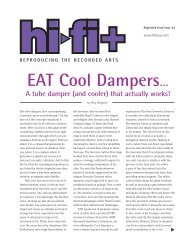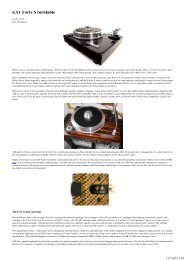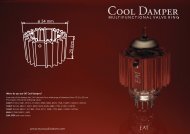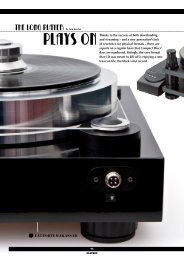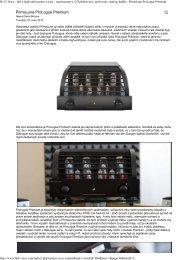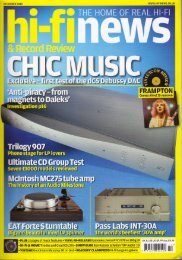EAT E-Go Tonearm - EuroAudioTeam.com
EAT E-Go Tonearm - EuroAudioTeam.com
EAT E-Go Tonearm - EuroAudioTeam.com
Create successful ePaper yourself
Turn your PDF publications into a flip-book with our unique Google optimized e-Paper software.
RIGHT: The titanium arm wand is attached<br />
by a screw connector to the massive bearing<br />
housing, whose knurled top cap can be<br />
unscrewed to access the bearing cup and add<br />
the viscous damping fluid. Seen right is the VTA<br />
adjuster with its Vernier scale for fine tuning<br />
On first<br />
installation,<br />
having removed<br />
the blue plastic<br />
transit sleeve from<br />
the unipivot point,<br />
you fill the cup with an<br />
appropriate quantity of<br />
damping oil, then replace<br />
the cap. Alongside, the antiskate<br />
<strong>com</strong>pensation is not magnetic but<br />
achieved by a time-honoured thread-andweight<br />
system. But here, from a bell-crank<br />
that carries the adjustable weight, the<br />
thread runs round a small but exquisite<br />
pulley and is attached to the swivelling foot<br />
of the azimuth tower, avoiding the need<br />
for a direct connection to the arm.<br />
Azimuth adjustment is carried out<br />
by raising or lowering the magnet via a<br />
screwthread on its swivelling tower, this<br />
causing the arm to tilt as required. While<br />
you must not adjust azimuth during play,<br />
you can adjust the arm height and hence<br />
the vertical tracking angle – ‘VTA on the fly’<br />
has been a feature of Graham arms from<br />
the very start.<br />
Although the arm looks <strong>com</strong>plicated<br />
and even mysterious in its many<br />
GRAHAM ENGINEERING<br />
adjustments, it’s actually quite user friendly<br />
and <strong>com</strong>es with clear instructions. Our <strong>EAT</strong><br />
E-<strong>Go</strong> had the SME base, which of course<br />
made installation a painless procedure.<br />
As with previous models, it’s supplied<br />
with a neat device that registers the<br />
headshell with the turntable spindle to<br />
set the arm overhang correctly, and there<br />
is a special holder to provide accurate<br />
cartridge alignment.<br />
KEN SPINS SOME VINYL<br />
As the E-<strong>Go</strong> has a short back, it fitted<br />
the SME 30/12 without hitting the rear<br />
right pillar (as did my elderly SME 3012).<br />
Setup, despite the clever design, made me<br />
appreciate the genius of the SME Series<br />
V’s simplicity – but then the SME isn’t a<br />
unipivot. Thus, as far as ‘unis’ go, the E-<strong>Go</strong><br />
is one of the most user-friendly, as SH<br />
states. The removable wand makes it easy<br />
to change cartridges too: I settled on Air<br />
Tight’s PC1.<br />
Having just reviewed Gram Parsons’<br />
Grievous Angel as a MoFi SACD [HFN May<br />
’13], I dug out the vinyl [Reprise K54018]<br />
for more of the same. All was – how shall<br />
I put this? – wonderfully <strong>com</strong>prehensible<br />
until the end of ‘I Can’t Dance’.<br />
American engineer and designer Bob Graham can trace his passion for audio right<br />
back to the end of the mono era, when Weathers had its capacitance acitance cartridge<br />
mounted in a viscous-damped tonearm, tracking at a then-unprecedented unprecedented one<br />
gram. Graham recalls how salesmen would impress buyers by y casually tossing<br />
the arm on to the record, an act that would have caused<br />
serious damage with any other arm of the period. In<br />
the 1980s Graham took inspiration from SME’s superb<br />
engineering and finish and set out to build his own arms to similar imilar<br />
standards. While adopting the unipivot principle, he paid careful reful attention<br />
to the issues of resonance and dynamic stability, which he felt elt had been<br />
ignored by the designers of many other arms. The Graham 1.5 5 arm was<br />
launched in 1990, and this evolved into the 2.0 model and then en the 2.2. But<br />
in 2005 came the Phantom, a <strong>com</strong>pletely new design incorporating orating Graham’s<br />
patented Magneglide stabilisation system. Further enhancements ements brought the<br />
Phantom II and the current Phantom II Supreme, the basis of the <strong>EAT</strong> E-<strong>Go</strong>.<br />
We all have favourite tracks, parts of<br />
tracks even, we know so well that they<br />
serve as handy short-cuts for illustrating<br />
whether a system sounds convincingly<br />
realistic. They’ll be significant enough to<br />
convey a broad sensation, like voice, lead<br />
guitar, a strings section. As Parsons’ voice<br />
was so anodyne, that wasn’t gonna do it.<br />
What made me sit up and take notice was<br />
the drum-roll at the end of that track.<br />
It wasn’t mere impact: for that I’d<br />
turn to Kodo. It was about space and<br />
a lack of artifice. The sound of what is<br />
just a standard LP possessed the air and<br />
three-dimensionality of the crafted-to-amillimetre<br />
sound of the notorious Sheffield<br />
Drum Record. The crispness, the kick, lasts<br />
no more than a second, but the three that<br />
followed were to mere ‘air’ what Dyson is<br />
to dryers. I rubbed my eyes in disbelief.<br />
This confoundedness lasted only the<br />
length of the silence between tracks: it was<br />
followed by the delicate piano opening<br />
of ‘Brass Buttons’, <strong>com</strong>pounded by pedal<br />
steel and crisp, but discreet percussion.<br />
A snare, a cymbal, a woodblock, Parsons’<br />
vocals in the centre – the sound belied the<br />
title, for there was nothing brassy about it<br />
whatsoever. It managed, despite a surfeit<br />
of terse transients, to sound silky. And<br />
he hear hearing arin ing g it nnex<br />
next ext t to tthe<br />
the he admittedly aadm<br />
dmit itte tedl dly y cl clas classy assy sy<br />
SACD was an object lesson in why analogue<br />
remains more convincing than digital, for<br />
so many music music lovers.<br />
| www.hifinews.co.uk | Reprinted from HI-FI NEWS




